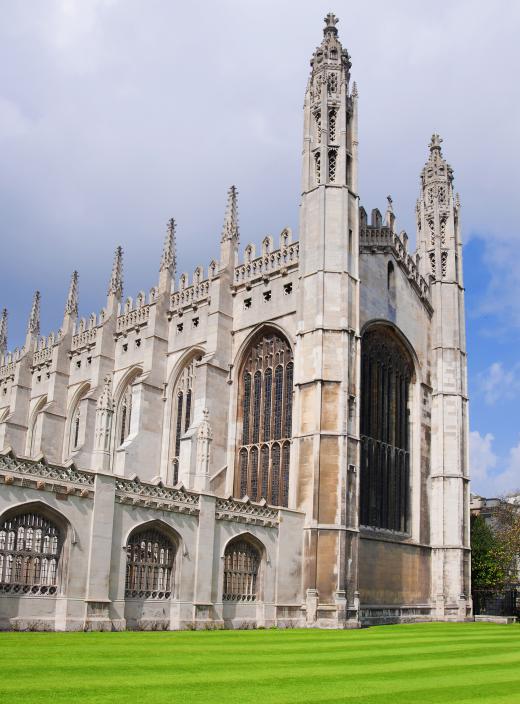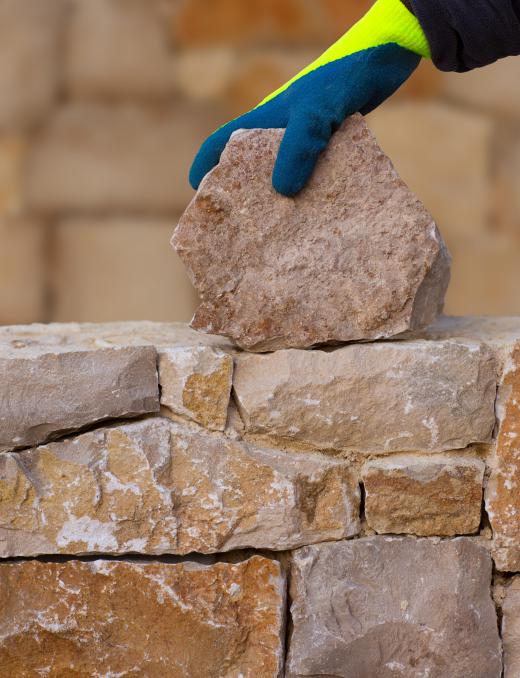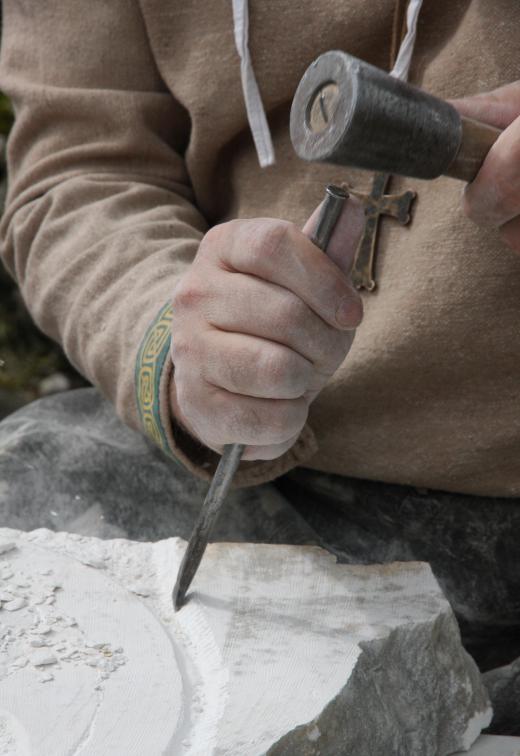What is Masonry?
 Mary McMahon
Mary McMahon
The term “masonry” refers to construction with stone. There is some dispute over the root of the word, but all of the candidates for the root are related to building with stone, such as the Latin maceria, which means “wall.” The term may be used to describe an entire building or a carved stone feature such as a headstone or bench. Someone who practices the art of masonry is called a stonemason or mason, and the skills of a mason tend to command high prices, since working in stone is very tricky.
When referring to a building, masonry describes the stonework which is incorporated into the building. One might say, for example, “the masonry in that building is quite distinctive,” Many old buildings were built entirely from stone, since it was a readily available construction material; many medieval cathedrals, for example, have stunning examples of masonry. Although stones can simply be piled on one another and anchored, most masonry is decorated with carvings to make it beautiful as well as functional.

Masonry incorporates several facets of engineering and physics, as stones must be carefully assembled to make a safe and solid building. Many ancient stone buildings illustrate incredible feats of architectural engineering, with vaulted arches which seem to stretch into the heavens and beautifully ornamented doorways, alcoves, and niches. Since stone is so heavy, correct placement and design is crucial, as imbalance can pull a whole structure down.

Carving in stone is very challenging because stone is such a hard and brittle material. Masons must carefully inspect each piece of stone that they work with, to ensure that it is suitable for their needs, and stone cannot be hurried. The next time you walk past a building with stone carving, take a close look and imagine using a hammer and chisel to carefully coax the carving from the stone. At each step, the mason is aware that an error will ruin the entire piece.

Masons typically train through apprenticeship with more experienced masons. The art is best learned through practice, with mentors showing apprentices how to use basic tools of the trade and how to assess rock for usefulness. Many masons in training experience immense frustration, as their errors may represent major setbacks in a project or a piece of art, but those who persist are rewarded for their labors with plentiful jobs and very appreciative customers.
AS FEATURED ON:
AS FEATURED ON:
















Discussion Comments
My dad was a mason and he always seemed to get a lot of satisfaction out of his work. But I have to put out there that it was absolutely murder on his hands. He would routinely come home with huge cuts and scrapes, callouses a half inch thick and mangled finger nails. Its not easy twisting and turning stone all day long.
@wander - This was probably not made exclusively by masons, but the Duomo cathedral in Florence Italy is probably the most impressive older structure I've ever seen.
Before I ever went I had seen pictures and could tell how impressive it was. But I was lucky enough to go to Italy once and see it in person and the pictures do not do it justice. I have never seen a building that looks so huge and imposing while also being graceful and smooth at the same time. It is really breathtaking and it seems to have the same effect on everyone who sees it. All around me there were gawking tourists with their jaws hanging open. Well done masons.
Many of today's building materials are relatively recent inventions. For a long time stone was the primary building material for large structures. Many of the most beautiful churches, castles and other amazing structures from the past were built out of stone by an army of masons.
These days being a mason seems like just another one of the trades, but it is these builders who built most of the lasting structures we have. Their impact on architecture, design and building cannot be overstated.
Many people are more familiar with the Freemasonry aspect of masonry. This secret society is famous for using the tools of the stonemasons as metaphors in their society.
I have always been fascinated by the giant Freemasons lodge located in the city near my hometown. The building is an amazing example of masonry work and is almost 200 years old. It is certainly one of the cities most impressive structures.
On that note, some other impressive structures attributed to the work of stonemasons include the pyramids, Angkor Wat and Stonehenge, just to name a few.
What do you think is the most interesting product or cultural icon created through stonemasons with their masonry work?
@anon80167 - Like many jobs the salary of a stonemason depends on how experienced they are, the quality of their work and what kind of work they do. The salary in the case of a stonemason varies widely, but on average starts at around $37,000 USD a year and goes up to around $75,000 USD.
There is a lot of work that goes into becoming a quality stonemason, and it can take many years to create a portfolio of your work and make a name for yourself.
With homeowners looking for more quality workmanship in their homes, this kind of trades work should continue to be readily available.
How much does a Mason get paid?
Post your comments